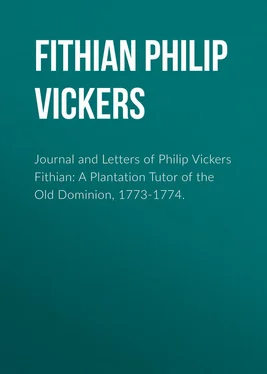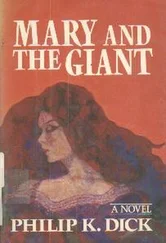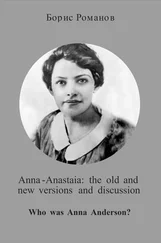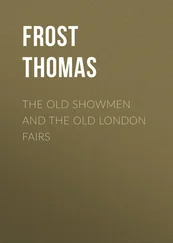Philip Fithian - Journal and Letters of Philip Vickers Fithian - A Plantation Tutor of the Old Dominion, 1773-1774.
Здесь есть возможность читать онлайн «Philip Fithian - Journal and Letters of Philip Vickers Fithian - A Plantation Tutor of the Old Dominion, 1773-1774.» — ознакомительный отрывок электронной книги совершенно бесплатно, а после прочтения отрывка купить полную версию. В некоторых случаях можно слушать аудио, скачать через торрент в формате fb2 и присутствует краткое содержание. Жанр: foreign_antique, foreign_prose, на английском языке. Описание произведения, (предисловие) а так же отзывы посетителей доступны на портале библиотеки ЛибКат.
- Название:Journal and Letters of Philip Vickers Fithian: A Plantation Tutor of the Old Dominion, 1773-1774.
- Автор:
- Жанр:
- Год:неизвестен
- ISBN:нет данных
- Рейтинг книги:3 / 5. Голосов: 1
-
Избранное:Добавить в избранное
- Отзывы:
-
Ваша оценка:
- 60
- 1
- 2
- 3
- 4
- 5
Journal and Letters of Philip Vickers Fithian: A Plantation Tutor of the Old Dominion, 1773-1774.: краткое содержание, описание и аннотация
Предлагаем к чтению аннотацию, описание, краткое содержание или предисловие (зависит от того, что написал сам автор книги «Journal and Letters of Philip Vickers Fithian: A Plantation Tutor of the Old Dominion, 1773-1774.»). Если вы не нашли необходимую информацию о книге — напишите в комментариях, мы постараемся отыскать её.
Journal and Letters of Philip Vickers Fithian: A Plantation Tutor of the Old Dominion, 1773-1774. — читать онлайн ознакомительный отрывок
Ниже представлен текст книги, разбитый по страницам. Система сохранения места последней прочитанной страницы, позволяет с удобством читать онлайн бесплатно книгу «Journal and Letters of Philip Vickers Fithian: A Plantation Tutor of the Old Dominion, 1773-1774.», без необходимости каждый раз заново искать на чём Вы остановились. Поставьте закладку, и сможете в любой момент перейти на страницу, на которой закончили чтение.
Интервал:
Закладка:
Footnote_12_12
William and Mary College Quarterly , Vol. XIX, series 1, p. 145.
Footnote_13_13
Robert Andrews, a Pennsylvania youth educated at "the College of Phileda," served as a tutor at "Rosewell," the Page home in Gloucester County, for several years, and two young men from Princeton taught the Carter children at "Nomini Hall." Cf. letter of John Page, Jr., to John Norton. "Rosewell," September 18, 1772, in Mason, Frances Norton, John Norton & Sons , p. 271. See also page 160.
Footnote_14_14
A "falling garden" consisted of a series of very broad terraces, usually connected by ramps covered with turf, oyster shell or other surface material to prevent erosion. In some instances the successive levels were planted in elaborate patterns. In others the whole was covered with turf. The "falling garden" at "Sabine Hall" retains its eighteenth-century design intact.
Footnote_15_15
A ha-ha is a boundary to a garden, pleasure-ground, or park of such a nature as not to interrupt the view from the mansion and may not be seen until closely approached. According to a French etymologist, the name is derived from ha , an exclamation of surprise, uttered by one suddenly approaching such a boundary. The ha-ha consists of a trench, the inner side of which is perpendicular and faced with a wall; the outer being sloped and turfed. The ha-ha permitted grazing cattle and sheep to appear on the landscape, and at the same time held them at a distance from the mansion. In his diary, George Washington refers, on several occasions, to the ha-has on the grounds at "Mount Vernon." Cf. Fitzpatrick, John, The Diaries of George Washington , Vol. II, passim .
Footnote_16_16
At "Mount Vernon" the mansion and its wings together composed three sides of an open square, the main house and its wings closing the side opposite the open end. At "Stratford Hall" four dependent structures formed a square court, inside of which the great house stands. Two offices are set twenty-eight feet in advance of the main house on the land front. On the water front two others are placed in a similar relation to it. At "Shirley" the great house and four principal dependent buildings form a long rectangular court, the mansion closing the side facing the river.
Footnote_17_17
A Huguenot Exile in Virginia , ed. and tr. by Gilbert Chinard (New York, 1934), p. 142. In writing of Maryland early in the eighteenth century, Sir John Oldmixon said: "Both here [Maryland] and there [Virginia] the English live at large at their several Plantations, which hinders the Increase of Towns; indeed every Plantation, is a little Town of itself, and can subsist itself with Provisions and Necessaries, every considerable Planter's Warehouse being like a Shop…" Oldmixon, John, British Empire in America (second edition, 1741), Vol. I, p. 339. Cf. Kimball, Fiske, Domestic Architecture , passim .
Footnote_18_18
A historian who described the Virginia residences at the beginning of the eighteenth century stated that "All their Drudgeries of Cookery, Washing, Daries, &c. are perform'd in Offices detacht from the Dwelling-Houses, which by this means are kept more cool and Sweet." Cf. Beverley, Robert, The History and Present State of Virginia , Book IV, p. 53.
Footnote_19_19
The Tidewater plantation economy had spread into the Piedmont section prior to the American Revolution. A paroled British officer writing of his situation in Albemarle County in 1779, said: "The house that we reside in is situated upon an eminence, commanding a prospect of near thirty miles around it, and the face of the country appears an immense forest, interspersed with various plantations, four or five miles distant from each other; on these there is a dwelling-house in the center, with kitchens, smoke-house, and out-houses detached, and from the various buildings, each plantation has the appearance of a small village; at some little distance from the houses, are peach and apple orchards, &c. and scattered over the plantations are the negroes huts and tobacco-houses, which are large built of wood, for the cure of that article." Cf. Anburey, Thomas, Travels Through the Interior Parts of America , Vol. II, p. 187.
Footnote_20_20
A British observer reported in 1779 that "… before the war, the hospitality of the country was such, that travellers always stopt at a plantation when they wanted to refresh themselves and their horses, where they always met with the most courteous treatment, and were supplied with every thing gratuitously; and if any neighbouring planters heard of any gentleman being at one of these ordinaries, they would send a negroe with an invitation to their own house." Cf. Anburey, Travels Through the Interior Parts of America , Vol. II, p. 198. This same traveller described the hospitality shown the guests at one of the James River plantations. "I spent a few days at Colonel Randolph's, at Tuckahoe, at whose house the usual hospitality of the country prevailed," he wrote. "It is built on a rising ground, having a most beautiful and commanding prospect of James River; on one side is Tuckahoe, which being the Indian name of that creek, he named his plantation Tuckahoe after it; his house seems to be built solely to answer the purposes of hospitality, which being constructed in a different manner than in most other countries; I shall describe it to you: It is in the form of an H, and has the appearance of two houses, joined by a large saloon; each wing has two stories, and four large rooms on a floor; in one the family reside, and the other is reserved solely for visitors: the saloon that unites them, is of a considerable magnitude, and on each side are doors; the ceiling is lofty, and to these they principally retire in the Summer, being but little incommoded by the sun, and by the doors of each of the houses, and those of the saloon being open, there is a constant circulation of air; they are furnished with four sophas, two on each side, besides chairs, and in the center there is generally a chandelier; these saloons answer the two purposes of a cool retreat from the scorching and sultry heat of the climate, and of an occasional ball-room. The outhouses are detached at some distance, that the house may be open to the air on all sides." Ibid. , p. 208.
Footnote_21_21
Cf. Wright, Louis B., Letters of Robert Carter, 1720-1727 (San Marino, 1940), p. viii.
Footnote_22_22
Cf. Jones, E. Alfred, American Members of the Inns of Court , p. 41.
Footnote_23_23
Sisters of Anne Bladen Tasker and Thomas Bladen had married Daniel Dulany, Samuel Ogle, and Christopher Lowndes, all men of important political and financial connections in their world.
Footnote_24_24
Four of the seventeen Carter children were born after Fithian had left the family.
Footnote_25_25
Some extracts from the Journal were published in the American Historical Review of January, 1900.
Footnote_26_26
Cf. Philip Fithian's Journal , edited by John Rogers Williams, p. xiv.
Footnote_27_27
Philip Vickers Fithian had left his home at Cohansie, New Jersey, in 1770, at the age of twenty-three, to enter the College of New Jersey at Princeton. Nassau Hall was the principal structure of the college, and the institution was often familiarly referred to by that name. Fithian was graduated there in September 1772. His parents had both died suddenly during the previous February. Andrew Hunter, Jr., of Cohansie, who wrote this letter, was the nephew of the Reverend Andrew Hunter, Sr., of Greenwich, New Jersey, under whom Philip was at this time studying Hebrew in connection with his preparation for the ministry.
Читать дальшеИнтервал:
Закладка:
Похожие книги на «Journal and Letters of Philip Vickers Fithian: A Plantation Tutor of the Old Dominion, 1773-1774.»
Представляем Вашему вниманию похожие книги на «Journal and Letters of Philip Vickers Fithian: A Plantation Tutor of the Old Dominion, 1773-1774.» списком для выбора. Мы отобрали схожую по названию и смыслу литературу в надежде предоставить читателям больше вариантов отыскать новые, интересные, ещё непрочитанные произведения.
Обсуждение, отзывы о книге «Journal and Letters of Philip Vickers Fithian: A Plantation Tutor of the Old Dominion, 1773-1774.» и просто собственные мнения читателей. Оставьте ваши комментарии, напишите, что Вы думаете о произведении, его смысле или главных героях. Укажите что конкретно понравилось, а что нет, и почему Вы так считаете.












